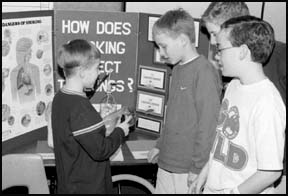 <
The sixth graders at Paynesville Area Middle School had an open house for two hours Friday afternoon to display their science projects.
<
The sixth graders at Paynesville Area Middle School had an open house for two hours Friday afternoon to display their science projects.All the sixth graders' projects were displayed in the sixth grade teachers' rooms and in the middle school media center. Parents, teachers, and seventh and eighth grade students had the opportunity to walk around and look at the various projects. The sixth grade students were eager to explain their research to anyone stopping by their display.
"These are really nice," said Bob Bowden, sixth grade science teacher. "There are some really creative ones."
The sixth graders start their projects in November. Sixth grade science teacher Bob Bowden spends several days discussing their projects and showing slides and videos of projects from previous years.
"The majority of the work is done outside of class," said Bowden. He sets some deadlines for choosing a topic, and he did take his classes to the library to do research for a couple days in January, but otherwise the students are responsible for their project.
The science projects fulfill an inquiry standard for the middle school Profile of Learning.
"A science project provides a unique opportunity for students to engage in a long-term research project and investigation. It will require the use of the scientific method as well as research and library skills. In addition it gives the students a chance to develop their communication skills as they prepare a summary and oral presentation," explained Bowden in a letter to parents in November.
The basic method for students is to identify a question or problem, research and collect information, form a hypothesis, experiment to test your hypothesis, and record your results.
Projects this year covered a wide range of topics. Investigations into how things worked included steam engines, suspension bridges, microwaves, film development, and the heart. Another popular topic was looking at a particular disease, its causes, and its consequences.